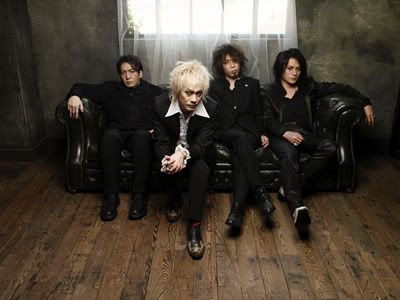Visual kei (ヴィジュアル系 bijuaru kei, lit. "visual style" or "visual system") is a movement among Japanese musicians, that is characterized by the use of make-up, elaborate hair styles and flamboyant costumes, often, but not always, coupled with androgynousaesthetics. Some sources think that visual kei refers to a music genre with its sound usually related to glam rock, punk rock and heavy metal. However, this is contradictory to the fact that visual kei acts play various genres, including those unrelated to rock such as electronic, pop, etc Other sources, including members of the movement themselves, state that it is not a music genre and that the fashion and participation in the related subculture is what exemplifies the use of the term .
History
Visual kei emerged in the early 1980s, pioneered by bands such as X Japan, D'erlanger, Buck-Tick and Color.[6][18] The term visual kei is believed to come from one of X Japan's slogans, "Psychedelic violence crime of visual shock".[18][19] There are two record labels, both founded in 1986, that were instrumental for helping the visual kei scene spread, they are Extasy Records in Tokyo and Free-Will in Osaka.[18]
Extasy was created by X Japan's drummer and leader Yoshiki and signed bands, not limited to visual kei acts, that would go on to make marks on the Japanese music scene, including Zi:Kill, Tokyo Yankees and Ladies Room. Glay and Luna Sea, who went on to sell millions of records, with Glay being one of Japan's best-selling musical acts, had their first albums released by Extasy Free-Will was founded by Color vocalist and leader Dynamite Tommy, while at the time not as popular as Extasy, it had many moderately successful acts, such as By-Sexual and Kamaitachi.[18] Currently Free-Will is still going strong and has been a major contributor in spreading modern visual kei outside Japan, whereas Extasy followed its owner and became based out of the US, signing and producing American acts, and has since faded away.
In 1992, X Japan tried to launch an attempt to enter the American market, even signing with Atlantic Records for a US album, but this ultimately did not happen. It would take another 8 years until popularity and awareness of visual kei bands would extend worldwide.[ In the mid 1990s, visual kei received increasing popularity throughout Japan, when album sales from visual kei bands started to reach record numbers. The most notable bands to achieve success during this period included X Japan, Glay and Luna Sea; however, a drastic change in their appearance accompanied their success. During the same period other bands, such asKuroyume, Malice Mizer and Penicillin, gained mainstream awareness, although they were not as commercially successful. By 1999, the mainstream popularity of visual kei was declining; X Japan had disbanded, and in 2000, Luna Sea decided to disband as well.
Notable newer visual kei bands include Dir en Grey, Alice Nine, The Gazette and D'espairsRay, who have all performed overseas. Veterans of the scene have also established new acts, such as Malice Mizer's Mana with his band Moi dix Mois, and several members of Pierrot forming Angelo In 2007, visual kei was revitalized as Luna Sea performed a one-off performance and X Japan officially reunited with a new single and a world tour. With these developments, visual kei bands enjoyed a boost in public awareness, with bands formed around 2004 having been described by some media as "neo-visual kei" (ネオ・ヴィジュアル系)
However, there has been criticism about newer visual kei bands having lost the spirit of their forefathers, copying each other and becoming all the same. Kirito, vocalist of Pierrot and Angelo, said "Now it’s more like people are dressing up a certain way because they want to be visual kei or look visual kei. They are doing it to look like others instead of doing it to look different. This is obviously very different from when we started out more than ten years ago.", and Sugizo of Luna Sea expressed concern that "They cannot make good sounds and music is more like a hobby for them. I cannot feel their soul in the music". Kenzi of Kamaitachi, The Dead Pop Stars and Anti Feminism commented "Back in the day, there were bands, but people would try to do things differently. Nowadays, there’s one band, and everyone copies off of them.", with Free-Will founder and Color frontman Tommy concluding with "I don’t think our breed of visual kei exists anymore.
Popularity
Visual kei has enjoyed popularity among independe
nt underground projects, as well as artists achieving mainstream success, with influences from Western phenomena, such as glam, goth and cyberpunk. The music performed encompasses a large variety ofgenres, i.e. punk, metal, pop and electronica Magazines published regularly in Japan with visual kei coverage are Arena 37°C,Cure, Fool's Mate and Shoxx. Noted bands who at least at some point sported a visual kei theme include Dir En Grey Luna Sea and Malice Mizer. ]The popularity and awareness of such groups outside of Japan has seen an increase in recent years.
nt underground projects, as well as artists achieving mainstream success, with influences from Western phenomena, such as glam, goth and cyberpunk. The music performed encompasses a large variety ofgenres, i.e. punk, metal, pop and electronica Magazines published regularly in Japan with visual kei coverage are Arena 37°C,Cure, Fool's Mate and Shoxx. Noted bands who at least at some point sported a visual kei theme include Dir En Grey Luna Sea and Malice Mizer. ]The popularity and awareness of such groups outside of Japan has seen an increase in recent years.

















Không có nhận xét nào:
Đăng nhận xét